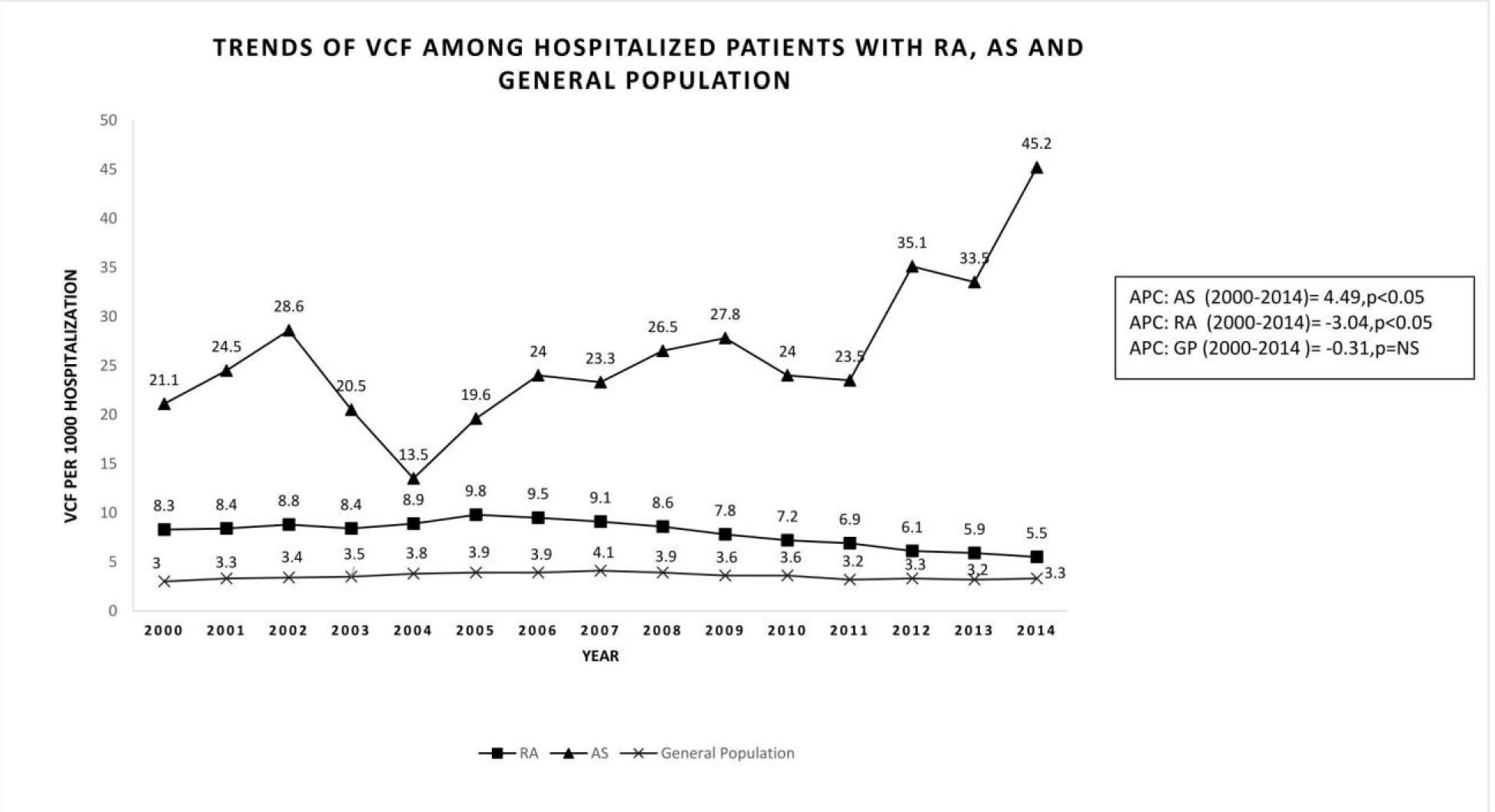Session Information
Date: Monday, November 9, 2020
Session Type: Poster Session D
Session Time: 9:00AM-11:00AM
Background/Purpose: Ankylosing spondylitis (AS) is a chronic inflammatory disease predominantly affecting the spine, leading to syndesmophyte formation, ankylosis, and osteoporosis. These factors have been associated with an increased risk of vertebral fractures after minor trauma. Whether improved recognition of AS and more effective management including biologics have impacted the risk of vertebral fractures is unclear. The aim of our study was to assess the yearly trends of vertebral compression fractures (VCF) among hospitalized patients with AS compared to RA and the general population.
Methods: National Inpatient Sample (NIS) database from the years 2000-2014 was used to identify adult (≥18 years age) hospitalizations. NIS is the largest all-payer inpatient database in the US and represents 20% stratified sample of all hospital discharges. Previously validated ICD-9 diagnosis codes at secondary diagnosis positions were used to identify hospitalizations with AS (720.0) and RA (714.0, 714.1, 714.2). We created 3 mutually exclusive groups of cohorts: AS, RA and a third group from the general population without diagnoses of AS or RA as controls. VCF hospitalizations were identified in these 3 groups using validated ICD-9 codes (805.2, 805.4, 805.8, 733.13) at the primary diagnosis position. ICD-9 codes for malignant neoplasms, bone and plasma cell neoplasms, or non-specific hemangiomas (140.xx-208.xx, 228.09, 238.0, 238.6, 239.2) were used to exclude patients with malignancies and pathologic bone processes except osteoporosis. STATA version 16 and Joinpoint regression were used to analyze trends in VCF hospitalizations.
Results: In the years 2000-2014, there were a total of 4,364 (2.70%), 45,218 (0.77%), and 1,432,232 (0.35%) VCF hospitalizations in AS, RA and in the general population controls, respectively. Females accounted for 28.1%, 84.6%, and 67.3% VCF hospitalizations in AS, RA, and general population controls, respectively. Mean ages for VCF hospitalization were 71.4, 75.1, 71.6 years for AS, RA, and general population controls, respectively.
From the year 2000 to 2014, an overall increasing trend of VCF hospitalizations in AS (APC= 4.49, p < 0.05) was seen, in contrast to a decreasing trend in RA (APC= - 3.04, p < 0.05). The trend of VCF in the general population was stable over the years studied (APC = -0.31, p= NS) (Fig 1).
Conclusion: The trend of VCF hospitalizations in AS was noted to be increasing compared to a declining trend in RA and a stable trend in the general population. Early diagnosis and improved management of RA might have led to lower VCF hospitalizations in RA over time. While the trends in RA are encouraging, findings in AS suggest the need to improve screening and prevention of osteoporosis and VCF in patients with AS.
 Trends in Hospitalizations for Vertebral Compression Fractures in Ankylosing Spondylitis compared to Rheumatoid Arthritis and General Population
Trends in Hospitalizations for Vertebral Compression Fractures in Ankylosing Spondylitis compared to Rheumatoid Arthritis and General Population
To cite this abstract in AMA style:
Paudel A, Dhital R, Poudel D, Donato A, Karmacharya P. Trends in Hospitalizations for Vertebral Compression Fractures in Ankylosing Spondylitis: Data from the National Inpatient Sample 2001-2014 [abstract]. Arthritis Rheumatol. 2020; 72 (suppl 10). https://acrabstracts.org/abstract/trends-in-hospitalizations-for-vertebral-compression-fractures-in-ankylosing-spondylitis-data-from-the-national-inpatient-sample-2001-2014/. Accessed .« Back to ACR Convergence 2020
ACR Meeting Abstracts - https://acrabstracts.org/abstract/trends-in-hospitalizations-for-vertebral-compression-fractures-in-ankylosing-spondylitis-data-from-the-national-inpatient-sample-2001-2014/
